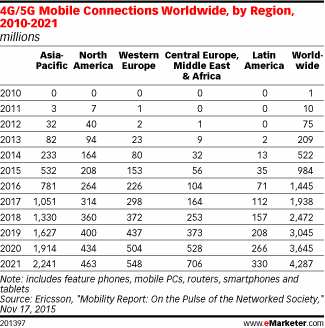B2C
How the 5G Revolution Will Transform Marketing
There’s a reason why smartphones didn’t take off in the late 2000s like they have in the past few years. Back when the iPhone was first released, wireless data was expensive, and doing much beyond finding directions and checking the weather was a pain.
Now, thanks to 4G and the ubiquity of Wi-Fi, using a smartphone as a portable internet platform makes much more sense. As a result, data-intensive apps like Uber and Tinder are possible and popular. So are chat and social apps.
Though smartphones were the portal to all this change, we wouldn’t be where we are now without the spread of 4G and Wi-Fi. The same will be true of the internet of 2020, which is when industry experts predict that 5G will become initially available to businesses and consumers.
5G will be a massive upgrade if it’s as good as promised. For one, it will be fast: about 10 times as fast as 4G. Most importantly, it will be everywhere—and in everything—through the Internet of Things (IoT). Cars (particularly driverless cars), houses, and everyday devices are all being built to communicate with one another. This means users will have the opportunity to “optimize” their daily lives by allowing their devices to sync. Plus, it means even more data for marketers.

The future of 5G, via Orange
Matt Goddard, the CEO of R2integrated, writes in Adweek’s SocialTimes how he sees advertising and the IoT evolving together with 5G, using the example of a smart refrigerator:
Offer the consumer ways to repurchase goods and introduce an ad network for food brands. Maybe you partner with a grocery delivery service and show a “Reorder” button on the fridge’s touchscreen; maybe you push inventory warnings to a smartphone app that automatically adds items to a grocery list; perhaps the fridge tells the smart TV to run milk ads on its streaming service. If the consumer buys milk at the grocery store using her mobile wallet, the wallet tells the TV to not run milk ads later that day.
Exactly how many connected “things” will be in use by 2020 is debated, but it will be a significant increase from today. Of course, that number should only increase even more when 5G is introduced. It’s no surprise that Goddard calls the IoT a “marketing gold mine.”
“If it computes, it must connect. Otherwise it might as well be a brick.”
At last year’s Intel Developer Forum, Aicha Evans, the general manager of Intel’s communications and devices group, made bold declarations for the IoT. According to Motherboard, she said that around 50 billion “things” will become connected by 2020. “If it computes, it must connect. Otherwise it might as well be a brick.”

Thanks to 5G, the mobile internet will be much faster globally by 2020.
Live streaming should evolve with 5G as well, since mobile streaming will be much faster and stable. At the moment, live streaming is a massive drain on data and not particularly high-quality.
With 5G, live streaming should become a lot like what watching mobile video is now: ubiquitous and easy. And considering how much giants like Facebook, Twitter, and traditional TV networks are investing in the format, it’s safe to say that live streaming—with the help of 5G—will be a major content format of the future.
Of course, there are some issues. While 5G will be much faster, that doesn’t mean that people with capped data plans will be able to use all that speed anymore than they already do. Unless that changes, live streaming will be easy, but still a big data drain.
The effects of 5G, like the mobile networks before it, aren’t entirely predictable. But it’s impossible to doubt that, once the structure for a much faster mobile web is in place, it will reshape what’s possible on mobile—and, in turn, our everyday lives.
This is an excerpt from “Media 2020: The Marketer’s Guide to the Future of the Internet.”
Image by Hannah WaldronGet better at your job right now.
Read our monthly newsletter to master content marketing. It’s made for marketers, creators, and everyone in between.




